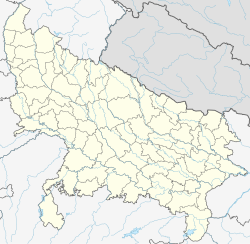Panwah
Today, we enter the exciting world of Panwah, a topic that has captured the attention of millions of people around the world. Since its inception, Panwah has been the subject of study, debate and interest, and its impact on society remains relevant today. In this article, we will explore the many facets of Panwah, from its history to its implications in everyday life. Through deep and thoughtful analysis, we will seek to better understand what Panwah means and why it is so significant today. Get ready to immerse yourself in a fascinating journey into the heart of Panwah!
Panwah | |
|---|---|
Village | |
| Coordinates: 27°25′07″N 78°52′14″E / 27.4187°N 78.87048°E | |
| Country | India |
| State | Uttar Pradesh |
| District | Mainpuri |
| Tehsil | Mainpuri |
| Area | |
• Total | 9.773 km2 (3.773 sq mi) |
| Population (2011)[1] | |
• Total | 2,955 |
| • Density | 300/km2 (780/sq mi) |
| Time zone | UTC+5:30 (IST) |
Panwah (Panwāh) is a village in Kuraoli block of Mainpuri district, Uttar Pradesh, India. It is located west of Kuraoli. There is a large depression near the village that used to be a lake. There is also an archaeological find site near the village. As of 2011, Panwah had a population of 2,955, in 500 households.
Geography
Panwah is located 15 km west of Kuraoli. 1 km east of Panwah is a mound where Ochre Coloured Pottery culture artifacts have been found. The soil in this area is hard and calcareous. To the south is a large depression that used to be a lake. It dried up after a canal was constructed, interrupting the drainage path that used to feed the lake.[2]: 301
Archaeology
Several pottery fragments associated with the Ochre Coloured Pottery culture have been found at the mound near Panwah. They were strewn over a large area, and not very many were found. The inhabitants of the ancient site probably used the drainage zone around the former lake for agriculture.[2]: 301
Demographics
As of 2011, Panwah had a population of 2,955, in 500 households.[1]: 91 This population was 52.4% male (1,548) and 47.6% female (1,407). The 0-6 age group numbered 571 (288 male and 283 female), or 19.3% of the total population. 210 residents were members of Scheduled Castes, or 7.1% of the total.[3]: 76–7
The 1981 census recorded Panwah as having a population of 1,720 people, in 278 households.[4]: 134–5
The 1961 census recorded Panwah as comprising 3 hamlets, with a total population of 1,056 people (572 male and 484 female), in 183 households and 151 physical houses. The area of the village was given as 550 acres.[5]: lxxiv
Infrastructure
As of 2011, Panwah had 1 primary school and 1 primary health centre. Drinking water was provided by hand pump; there were no public toilets. The village had a post office but no public library; there was at least some access to electricity for all purposes. Streets were made of both kachcha and pakka materials.[1]: 91–6
References
- ^ a b c d "Census of India 2011: Uttar Pradesh District Census Handbook - Mainpuri, Part A (Village and Town Directory)" (PDF). Census of India. Retrieved 19 June 2023.
- ^ a b Kumar, Vijay (2022). "OCP Settlement Pattern, Copper Hoard Weapons & Military Organization of the village and Interpretation of Anthropomorphic Figures" (PDF). Indian Journal of Archaeology. 7 (2): 207–305. Retrieved 17 November 2023.
- ^ "Census of India 2011: Uttar Pradesh District Census Handbook - Mainpuri, Part B (Village and Town Wise Primary Census Abstract)" (PDF). Census of India. Retrieved 19 June 2023.
- ^ Census 1981 Uttar Pradesh: District Census Handbook Part XIII-A: Village & Town Directory, District Mainpuri (PDF). 1982. Retrieved 25 July 2023.
- ^ Census 1961: District Census Handbook, Uttar Pradesh (24 - Mainpuri District) (PDF). Lucknow. 1965. Retrieved 25 December 2021.
{{cite book}}: CS1 maint: location missing publisher (link)
